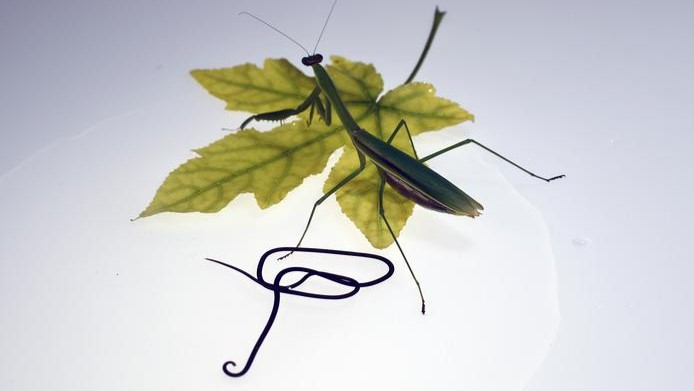Horrifying parasitic worm snatches its host's genes to control its mind
Horsehair worms flood their hosts' minds with proteins made from copied chunks of their own genomes.

Parasitic horsehair worms that dwell in the guts of praying mantises compel their hosts to walk to water and drown themselves.
Now, scientists have discovered the secret to these worms' horrifying mind control: They steal their hosts' genetic code.
By turning the mantises' own genes against them, horsehair worms (Chordodes formosanus) hijack their hosts with a molecule that causes them to march toward light shimmering off water. Once their victims have hurled themselves in, the adult worms writhe free. The researchers published their findings Thursday (Oct. 19) in the journal Current Biology.
Related: Green-banded broodsac: The brain-hijacking parasite that creates disco zombie snails
Horsehair worms' life cycle typically begins in ponds, puddles, pools and streams, where they hatch from eggs before hitchhiking to shore by sticking to aquatic insects. After being eaten by praying mantises and crickets, they grow rapidly inside their hosts, before unleashing a barrage of biochemical signals — remarkably similar to those used in the hosts' bodies — to transform their victims into powerless zombies.
To investigate how the worms achieved this molecular mimicry, the researchers performed a genetic analysis of the worms before, during and after they manipulated their mantis hosts.
The scientists discovered that when a host was being manipulated, 4,500 of the worm's genes changed in their expression, while the mantis's gene expressions remained unchanged — a sign that the worms were using the genes to make their own proteins.
Get the world’s most fascinating discoveries delivered straight to your inbox.
By looking up the involved genes in a database, the researchers discovered that 1,400 C. formosanus genes closely matched those belonging to the mantises, whose nerve systems the worm commandeered. These genes were missing from other horsehair worm species that don't use praying mantises as hosts.
"Strikingly, many of the horsehair worm genes that could play important roles in manipulating their hosts were very similar to mantid genes, suggesting that they were acquired through horizontal gene transfer," first author Tappei Mishina, a biologist at the RIKEN Center for Biosystems Dynamics Research, said in a statement.
Horizontal gene transfer, the shuttling of genes between individuals that are not a parent or offspring, was once considered to be a fairly rare process that happened only in bacteria. However, scientists recently found that it occurs in wild plants, plant parasites and even between snakes and frogs through shared parasites such as leeches.
By snatching new genes or functions, the process enables organisms to adapt more quickly than they could through mutation alone, and it's one reason for the growing antibiotic resistance of many superbugs.
"The many cases of horizontal gene transfer that we have found in the hairworm can be a good model for study," Tappei said. "Using this model, we hope to identify the mechanisms underlying horizontal gene transfer and advance our understanding of evolutionary adaptation."

Ben Turner is a U.K. based writer and editor at Live Science. He covers physics and astronomy, tech and climate change. He graduated from University College London with a degree in particle physics before training as a journalist. When he's not writing, Ben enjoys reading literature, playing the guitar and embarrassing himself with chess.



